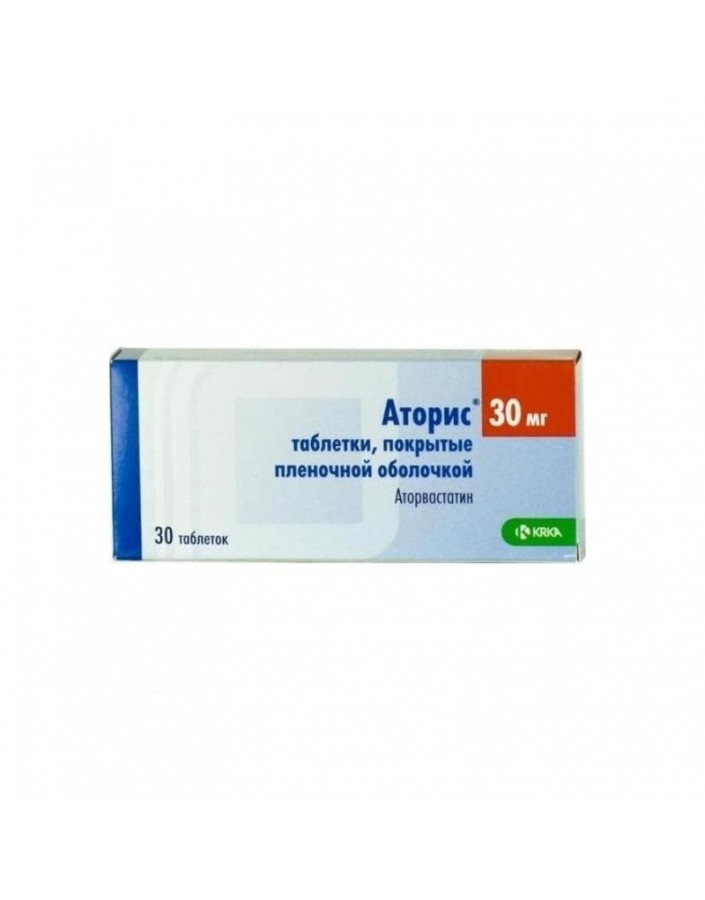




Security policy (edit with Customer reassurance module)

Delivery policy (edit with Customer reassurance module)

Return policy (edit with Customer reassurance module)
Film Coated Tablets
1 pill contains Atorvastatin (in the form of a Calcium salt) 30 mg;
Excipients: Povidone, sodium lauryl sulfate, calcium carbonate, microcrystalline cellulose, lactose monohydrate, croscarmellose sodium, Magnesium stearate.
shell composition: Opadry II HP 85F28751 white (polyvinyl alcohol, titanium dioxide (E171), macrogol 3000, talc).
30 pieces
Atoris is a lipid-lowering agent from the group of statins. Selective competitive inhibitor of HMG-CoA reductase - an enzyme that converts 3-hydroxy-3-methylglutaryl coenzyme A into mevalonic acid, which is a precursor of sterols, including cholesterol. TG and cholesterol in the liver are included in the composition of VLDL, enter the plasma and are transported to peripheral tissues. LDLs are formed from VLDL during interaction with LDL receptors. Reduces plasma cholesterol and lipoprotein levels by inhibiting HMG-CoA reductase, cholesterol synthesis in the liver and increasing the number of “liver” LDL receptors on the cell surface, which leads to increased uptake and catabolism of LDL. Reduces the formation of LDL, causes a pronounced and persistent increase in the activity of LDL receptors.Reduces the level of LDL in patients with homozygous familial hypercholesterolemia, which usually does not respond to therapy with lipid-lowering drugs. Reduces the level of total cholesterol by 30-46%, LDL - by 41-61%, apolipoprotein B - by 34-50% and TG - by 14-33%; causes an increase in cholesterol-HDL (high density lipoprotein) and apolipoprotein A. Dose-dependently reduces the level of LDL in patients with homozygous hereditary hypercholesterolemia resistant to therapy with other hypolipidemic drugs. Significantly reduces the risk of ischemic complications (including the development of death from myocardial infarction) by 16%, the risk of re-hospitalization for angina, accompanied by signs of myocardial ischemia, by 26%. It has no carcinogenic and mutagenic effects.
Primary hypercholesterolemia (heterozygos) type IV) resistant to dietary therapies. Homozygous hereditary hypercholesterolemia (as a supplement to lipid-lowering therapy, including autohemotransfusion of blood purified from LDL). Diseases of cardiovascular disease on the background of dyslipidemia, secondary prevention in order to reduce the overall risk of death, myocardial infarction and re-hospitalization for angina pectoris.
Hypersensitivity, active liver disease (includingactive, chronic alcoholic hepatitis), increased activity of "liver" transaminases (more than 3 times) of unclear genesis, liver failure (severity A and B on the Child-Pyuga scale), pregnancy, lactation period. C caution. Severe electrolyte imbalance, endocrine and metabolic disorders, alcoholism, history of liver disease, arterial hypotension, severe acute infections, uncontrolled seizures, extensive surgical interventions, injury, children's age (efficacy and safety of use have not been established).
The drug should be taken orally, take at any time of the day, regardless of the meal. The initial dose of Atoris is 10 mg once a day. Change the dose should be at least 4 weeks apart. The maximum daily dose is 80 mg in 1 reception. In case of primary hypercholesterolemia and combined (mixed) hyperlipidemia, 10 mg is prescribed 1 time per day. The effect appears within 2 weeks, the maximum effect is observed within 4 weeks. With homozygous familial hypercholesterolemia, 80 mg is prescribed 1 time per day (decrease in LDL content by 18-45%). Before starting treatment, the patient should be prescribed a standard cholesterol-lowering diet, which he must follow during treatment.
Atorvastatin can cause an increase in serum CPK, which should be taken into account in the differential diagnosis of chest pain.It is necessary to regularly monitor indicators of liver function before starting treatment, after 6 weeks and 12 weeks after starting the drug or after increasing the dose, and periodically during the entire period of use (until full normalization of patients whose transaminase levels exceed normal). An increase in liver transaminases is observed mainly in the first 3 months of the drug. It is recommended to cancel the drug or reduce the dose with an increase in AST and ALT more than 3 times. Atorvastatin should be discontinued with the development of clinical symptoms suggesting the presence of acute myopathy or in the presence of factors predisposing to the development of acute renal failure against the background of rhabdomyolysis (severe infections, hypotension, traumatic surgical interventions, trauma, metabolic, endocrine or pronounced electrolyte disorders). Patients should be warned that they should immediately consult a doctor if they develop unexplained pain or weakness in the muscles, especially if they are accompanied by indisposition or fever. Women of reproductive age should use reliable methods of contraception. In children, the experience with atorvastatin at a dose of 80 mg / day is limited.
With the simultaneous appointment of cyclosporine, fibrates, Erythromycin, Clarithromycin, immunosuppressive, antifungal drugs (related to azoles) and nicotinamide, atorvastatin concentration in plasma (and the risk of myopathy) increases.Antacids reduce the concentration by 35% (the effect on LDL cholesterol does not change). The simultaneous use of atorvastatin with protease inhibitors, known as cytochrome CYP3A4 inhibitors, is accompanied by an increase in plasma atorvastatin concentration. When using Digoxin in combination with atorvastatin at a dose of 80 mg / day, the concentration of digoxin increases by about 20%. Increases the concentration by 20% (when administered with atorvastatin at a dose of 80 mg / day) oral contraceptives containing norethindrone and ethinyl estradiol. The lipid-lowering effect of combination with colestipol is superior to that for each drug separately.
The drug should be stored at a temperature not higher than 25 ° C.